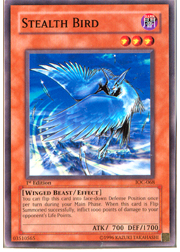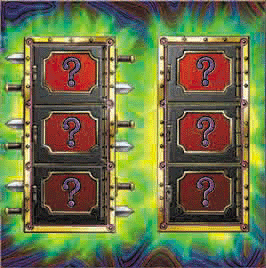 It’s true that a common version of Breaker the Magical Warrior and two copies of Magical Dimension are more than sufficient reasons to pick up a copy of the Spellcaster’s Judgment Structure Deck, but that’s not all the deck has to offer. Warrior’s Triumph had three new cards included with it, but Spellcaster’s Judgment simply beats the pants off it in both quantity and quality of new cards with a whopping six new additions to the game. Jae, Mike, and Curtis have already told you about three of these additions, and today I’m here to introduce you to the rest of them.
It’s true that a common version of Breaker the Magical Warrior and two copies of Magical Dimension are more than sufficient reasons to pick up a copy of the Spellcaster’s Judgment Structure Deck, but that’s not all the deck has to offer. Warrior’s Triumph had three new cards included with it, but Spellcaster’s Judgment simply beats the pants off it in both quantity and quality of new cards with a whopping six new additions to the game. Jae, Mike, and Curtis have already told you about three of these additions, and today I’m here to introduce you to the rest of them.
The first is one that I’ve already put to good use in my Spellcaster deck from Tuesday, and that’s Mythical Beast Cerberus. Cerberus starts off small and able to be fetched by both Shining Angel and Sangan, but once the spells start flying, Cerberus is going to get really big, really fast. For each spell played while Cerberus is on the field, it receives a spell counter that’s good for an extra 500 ATK at participating locations; however, at the end of a battle phase in which Cerberus engaged in combat, it loses all its spell counters. How is this useful, you ask? Well, while Cerberus plays nicely with all kinds of spells, its favorite kind is quick-play. By playing Cerberus in a deck filled with different kinds of quick-play spells, you can sucker your opponent into thinking that it’s safe to attack Cerberus—only to give it a surprise ATK boost after the attack declaration.
In my deck from Tuesday, I used Cerberus alongside the all-new Magical Dimension and the classic Mystical Space Typhoon, but I also played a copy of Rush Recklessly, which ends up giving Cerberus an extra 1200 ATK after all is said and done. That leaves it with 2600 ATK, and that’s more than enough to take out any commonly played monster, including Cyber Dragon, Mobius the Frost Monarch, and even a fully loaded Bazoo the Soul Eater without any unfortunate side effects. I imagine that it would be more than possible to build a deck based entirely on swarming the field with copies of Mythical Beast Cerberus and pumping them to massive proportions during battle using quick-play spells. You can also use protective spells to keep Cerberus from getting involved in battle until it’s nice and big, which brings me to the next card that I’ll be talking about: Nightmare’s Steelcage.
The Steelcage is an interesting card that bears a striking resemblance to the popular Swords of Revealing Light. Originally used in the TV show by Marik during his possession of Strings to hold Yugi down long enough for Slifer to be summoned. The more I think about it, the more I think of Steelcage as the evil version of Swords of Revealing Light. Interestingly enough, its effect hasn’t changed since it was brought from television to reality. Nightmare’s Steelcage remains on the field for two of your opponent’s turns after you activate it, and as long as it remains on the field, no monsters can attack. Note that this doesn’t stop you or your opponent from entering into the battle phase, so if you have something that you desperately need to do there that doesn’t involve attacking, feel free to do so.
 Nightmare’s Steelcage is the perfect card for decks that need more than one copy of Swords of Revealing Light for whatever reason, and aren’t really intending to attack during those turns. Stall/Burn comes to mind as a good candidate for this card, but those decks usually use Level Limit – Area B as their main method of stalling. The best place for Nightmare’s Steelcage is probably in the side deck against super-aggressive weenie rush decks. Level Limit doesn’t stop Mystic Swordsman LV2, but Nightmare’s Steelcage can keep the little rascal locked down long enough for you to get three extra flips out of that Stealth Bird, assuming that your opponent can’t reach his or her removal. The best part is that Steelcage isn’t limited at all, so you’re free to play three of them if you so desire.
Nightmare’s Steelcage is the perfect card for decks that need more than one copy of Swords of Revealing Light for whatever reason, and aren’t really intending to attack during those turns. Stall/Burn comes to mind as a good candidate for this card, but those decks usually use Level Limit – Area B as their main method of stalling. The best place for Nightmare’s Steelcage is probably in the side deck against super-aggressive weenie rush decks. Level Limit doesn’t stop Mystic Swordsman LV2, but Nightmare’s Steelcage can keep the little rascal locked down long enough for you to get three extra flips out of that Stealth Bird, assuming that your opponent can’t reach his or her removal. The best part is that Steelcage isn’t limited at all, so you’re free to play three of them if you so desire.
Steelcage also gives you some extra turns to set up whatever huge combos you may have planned for your opponent. Decks based on Armed Samurai – Ben Kei are probably pleased with this new addition, as it gives you some extra turns to flip your Iron Blacksmith – Kotetsus and Dekoichi the Battlechanted Locomotives to get to the cards you’ll need to win the game. You can even use Giant Trunade to put it back into your hand like a Swords of Revealing Light to get more use out of it, though it isn’t as effective as Swords on that account. Of course, that doesn’t even matter to Combo players, as they don’t want any spells or traps on the field anyway—except for the ones they need to win, which are usually easily replayed after the Trunade. Speaking of combo decks, have you heard the one about the Amoeba that made the other guy feel real bad about himself? I have, and it’s all thanks to the last card I’ll be talking about today, which is Mystic Box.
 Mystic Box was initially one of Yugi’s Dark Magician support cards introduced during the Duelist Kingdom season of the show. It was used during his tag-team duel with Joey against the Paradox Brothers to switch the places of Dark Magician and Jirai Gumo, along with skewering the spider with a load of holographic swords. The real-life card does something very similar, but there is a key difference that you should be aware of. When you play Mystic Box you choose two monsters, one on your side of the field, and one on the opponent’s side of the field. When the card resolves, the opponent’s monster is destroyed, and then your opponent gains control of your monster. Unlike the TV show where Yugi retained command of his Magician, use of the real Mystic Box lets you take out any opposing monster as long as you’re willing to give them one of yours as reparations. This can be handy, considering that you can give them any monster you control. For example, I could destroy your Mobius or Cyber Dragon. Then I’ll give you my Mystic Tomato. Then I beat up the Tomato, claim its effect for myself to summon Spirit Reaper or Don Zaloog, and mess you up, big time.
Mystic Box was initially one of Yugi’s Dark Magician support cards introduced during the Duelist Kingdom season of the show. It was used during his tag-team duel with Joey against the Paradox Brothers to switch the places of Dark Magician and Jirai Gumo, along with skewering the spider with a load of holographic swords. The real-life card does something very similar, but there is a key difference that you should be aware of. When you play Mystic Box you choose two monsters, one on your side of the field, and one on the opponent’s side of the field. When the card resolves, the opponent’s monster is destroyed, and then your opponent gains control of your monster. Unlike the TV show where Yugi retained command of his Magician, use of the real Mystic Box lets you take out any opposing monster as long as you’re willing to give them one of yours as reparations. This can be handy, considering that you can give them any monster you control. For example, I could destroy your Mobius or Cyber Dragon. Then I’ll give you my Mystic Tomato. Then I beat up the Tomato, claim its effect for myself to summon Spirit Reaper or Don Zaloog, and mess you up, big time.
You can also send tokens over, so it’s perfectly acceptable to send over an attack position Sheep token with your condolences for the loss of your opponent’s D.D. Assailant. Finally, unlike Creature Swap, your opponent can’t chain with his or her own Scapegoat to ruin your plans, because you’re the only one who’s giving anything away.
Mystic Box is also the key card for one of the most annoying decks in existence. I don’t think it has a proper name yet, so for now I’ll refer to it as the Swap Meet deck. It involves using Mystic Box to wreck your opponent’s good monsters and trade an Amoeba in return. This sets off the Amoeba’s effect, dealing 2000 damage to the opponent. You can add more damage on to that by destroying Amoeba with Mother Grizzly or something that when destroyed in battle next turn will fetch you another Amoeba. Continue by using Creature Swap, Shien’s Spy, and Mystic Box to send over enough Amoebas to get the opponent down to very small amounts of life points, and finish things off with a burn card to win. Look for it appearing in a local tournament near you within the next couple weeks. In fact, I may feature it myself sometime soon . . .
In any case, Mystic Box is a great card for all kinds of decks, from the competitive to the truly jank-tacular, and I’m going to be picking up a couple Structure Decks if only to get multiple copies of it. Spellcaster’s Judgment is a great addition to anyone’s card pool, from the beginners to the veterans, so if your local game store doesn’t have it yet, make sure you put one on hold. It’s going to be a quick seller. Until next time, play hard, play fair, and most importantly, have fun!
Jerome McHale
jcmchale AT andrew DOT cmu DOT edu